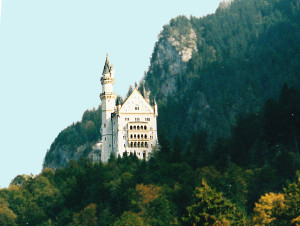If the castle in the picture looks familiar, but you have never been to Germany, the explanation is not a prior life as a Bavarian prince. The castle, built by an eccentric king deposed for claimed insanity, is the model for Disneyland’s Sleeping Beauty castles.
Ludwig II became king of Bavaria in 1864 at age 18. Shy and aloof, Ludwig loved theatre and the operas of Richard Wagner, whose career he rescued. Ludwig particularly admired tales of medieval kings in fairy tale castles. So in 1869, relying on his personal fortune, he began building a refuge in the foothills of the Bavarian Alps to match his fantasies. Conceived by a set designer, the plans envisioned a 65,000 square feet castle, with Romanesque towers and 200 lavishly appointed rooms.
By 1885, only about 15 rooms had been completed, including a throneless throne room inspired by Turkey’s Hagia Sophia. Because of Ludwig’s ever more grandiose ideas, construction costs were already double the original budget and Ludwig was deeply in debt. Some of the extra costs were incurred installing the latest technology, including electric bells to summon the staff.
After Ludwig had stayed in his unfinished castle about six months, his ministers had him declared insane. The evidence included little more than his obvious obsession with the castle. On June 12, 1886, Ludwig was deposed and the next day he was found dead in waist-deep water in Lake Starnberg. The death was labeled a suicide by drowning, but many suspect he was murdered. Ludwig’s body was interred in Munich’s St. Michael’s Church and his heart placed in an urn in a chapel in the Bavarian town of Altötting.
After Ludwig’s death, his castle was named “Neuschwanstein” (New Swan Stone) and its few completed rooms, some decorated with frescoes representing Wagner’s operas, were opened to a paying public. Today, the king once derided as “Mad Ludwig” is beloved by Bavarians, in part because of the enormous popularity of his castle. Every day in the summer, about 6,000 visitors to Neuschwanstein pour money into Bavaria’s economy, helping make it the richest state in Germany. King Ludwig, take a bow.
